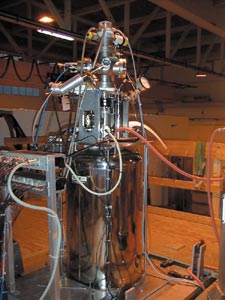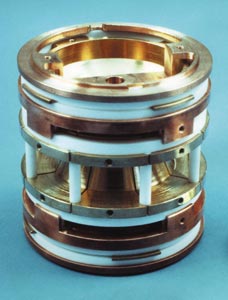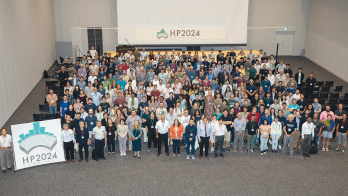
The mass of a nuclide is one of its most fundamental properties, being a unique “fingerprint”, and its measurement contributes to a variety of fundamental studies including tests of the Standard Model and the weak interaction. Now researchers using the Penning trap mass spectrometer, ISOLTRAP, at the ISOLDE facility at CERN have published new high-precision measurements of the mass of short-lived radionuclides of argon and copper, which provide important information for weak interaction and nuclear shell model physics.
The studies make use of recent improvements to ISOLTRAP, which can now analyse radionuclides with very short half-lives (~50 ms) produced in small numbers (~100 ions/s). The apparatus, which is fed by the 60 keV ion beam from ISOLDE, consists of three traps. A radiofrequency quadrupole ion trap accumulates and bunches the ions, and a first Penning trap then cools and purifies the beam. A second Penning trap finally provides the mass measurement by using a time-of-flight detection technique to determine the cyclotron frequency of the ions of interest.

A team from CERN, CSNSM-IN2P3-CNRS Orsay, GSI-Darmstadt and Michigan State University has measured the masses of 32Ar (half-life of 98 ms) and 33Ar (half-life 173 ms) with relative uncertainties of 6.0 x 10-8 and 1.4 x 10-8, respectively (Blaum et al. 2003) – the greatest precision to date on these nuclides. The results provide a stringent test of the isobaric-multiplet mass equation, which relates the masses of an isospin multiplet; 33Ar is a member of a quartet with an isospin of 3/2, while 32Ar is a member of a quintet with an isospin of 2. Such tests are of practical importance as the equation can predict unmeasured nuclear masses and energy levels, used for example in calculations of astrophysical processes. The mass of 32Ar also provides a better value for the beta-neutrino angular correlation coefficient, used to provide constraints on scalar contributions to the weak interaction.
In a second recent experiment, a larger collaboration, including members from the universities of Greifswald, Gent, Stockholm, IKS Leuven and the Russian Academy of Science, identified unambiguously three beta-decaying isomers in 70Cu. In this case the unique combination of resonant laser ionization, nuclear spectroscopy and mass measurements has allowed the determination of the low-energy nuclear structure of 70Cu. Using mass spectrometry the ground state (half-life of 44.5 s) and two excited states (half-lives of 33 and 6.6 s) were clearly distinguished and identified (Van Roosbroeck et al. 2004). As 70Cu has 41 neutrons, the results provide an important step in understanding the complex structure of nuclides with one neutron less, N = 40, which corresponds to a closed sub-shell. It also demonstrates, for future nuclear-structure studies, the power of the techniques used.
Further reading
K Blaum et al. 2003 Phys. Rev. Lett. 91 260801.
J Van Roosbroeck et al. 2004 Phys. Rev. Lett. (in print; see also CERN-EP/2003-076).





